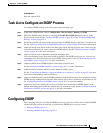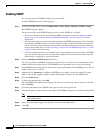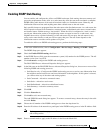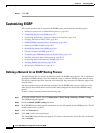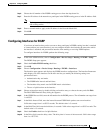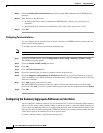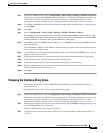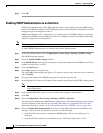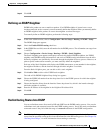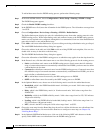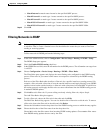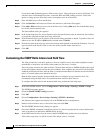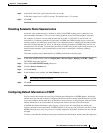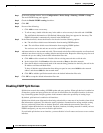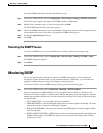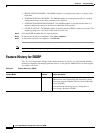
30-11
Cisco ASA 5500 Series Configuration Guide using ASDM
Chapter 30 Configuring EIGRP
Customizing EIGRP
Step 12 Click OK.
Defining an EIGRP Neighbor
EIGRP hello packets are sent as multicast packets. If an EIGRP neighbor is located across a non
broadcast network, such as a tunnel, you must manually define that neighbor. When you manually define
an EIGRP neighbor, hello packets are sent to that neighbor as unicast messages.
To manually define an EIGRP neighbor, perform the following steps:
Step 1 In the main ASDM window, choose Configuration > Device Setup > Routing > EIGRP > Setup.
The EIGRP Setup pane appears.
Step 2 Check the Enable EIGRP routing check box.
Step 3 In the EIGRP Process field, enter the AS number for the EIGRP process. The AS number can range from
1 to 65535.
Step 4 Choose Configuration > Device Setup > Routing > EIGRP > Static Neighbor.
The Static Neighbor pane appears and displays the statically-defined EIGRP neighbors. An EIGRP
neighbor sends EIGRP routing information to and receives EIGRP routing information from the ASA.
Normally, neighbors are dynamically discovered through the neighbor discovery process. However, on
point-to-point, nonbroadcast networks, you must statically define the neighbors.
Each row of the Static Neighbor table displays the EIGRP autonomous system number for the neighbor,
the neighbor IP address, and the interface through which the neighbor is available.
From the Static Neighbor pane, you can add or edit a static neighbor.
Step 5 Click Add or Edit to add or edit a EIGRP static neighbor.
The Add or Edit EIGRP Neighbor Entry dialog box appears.
Step 6 Choose the EIGRP AS number from the drop-down list for the EIGRP process for which the neighbor
is being configured.
Step 7 Choose the Interface Name from the Interface Name drop-down list, which is the interface through
which the neighbor is available.
Step 8 Enter the IP address of the neighbor in the Neighbor IP Address field.
Step 9 Click OK.
Redistributing Routes Into EIGRP
You can redistribute routes discovered by RIP and OSPF into the EIGRP routing process. You can also
redistribute static and connected routes into the EIGRP routing process. You do not need to redistribute
connected routes if they fall within the range of a network statement in the EIGRP configuration.
Note For RIP only: Before you begin this procedure, you must create a route-map to further define which
routes from the specified routing protocol are redistributed in to the RIP routing process. See Chapter 26,
“Defining Route Maps,” for more information about creating a route map.



